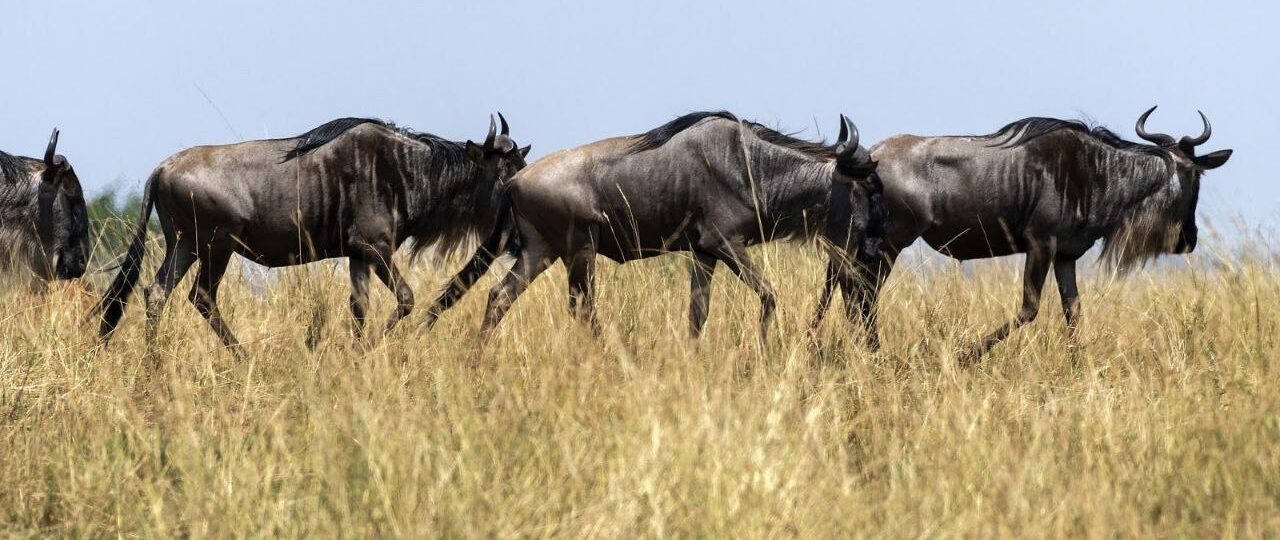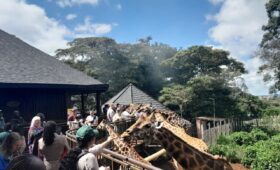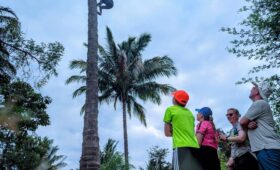In Kenya and Tanzania each year, over 1.5 million wildebeests, accompanied by hundreds of thousands of zebras, gazelles, and elands, embark on an epic journey across the East African plains a journey driven by survival, rainfall and instinct. This natural spectacle, known as the Great Wildebeest Migration, is one of the most breathtaking wildlife events in the world and a bucket list experience for nature lovers and safari travelers alike.
What is the Wildebeest Migration?
The Great Migration is an annual, circular movement of animals between Serengeti National Park in Tanzania and Maasai Mara National Reserve in Kenya. The journey covers over 1,800 miles, as herds traverse grasslands, face predators and cross perilous rivers in search of fresh grazing land and water.
Unlike a single-time event, the migration is a year round cycle, with different phases offering distinct wildlife action from calving in the south to dramatic river crossings in the north.
Month-by-Month Migration Timeline
January – March: Calving Season in Southern Serengeti
The migration begins in the Ndutu plains of southern Serengeti and Ngorongoro Conservation Area. Here, the wildebeest settle to give birth, with over 500,000 calves born in just a few weeks. This attracts predators like lions, cheetahs, and hyenas, creating thrilling predator-prey interactions.
April – May: The Herds Begin to Move
As the rains end and the grass starts to dry, the herds begin their slow journey northwest. These months see long columns of wildebeests moving in unison an awe-inspiring sight. Though less dramatic, it’s a great time for peaceful game drives.
June – July: Grumeti River Crossings
In the Western Corridor of Serengeti, the herds face their first major challenge: crossing the Grumeti River, home to giant crocodiles. The crossings are intense, and the drama is high as wildebeests leap into waters teeming with predators.
August – October: Mara River Crossings and the Maasai Mara
By August, the migration reaches the Mara River on the border of Kenya. This is the most famous and visually iconic stage of the migration. Thousands plunge into the river, where crocodiles lie in wait, and the strong current tests their endurance. Those who make it cross into Maasai Mara, Kenya’s premier safari destination.
November – December: Return to the Serengeti
With the onset of short rains in the south, the herds begin heading back to Serengeti. They graze along the way, gradually returning to the calving grounds, thus completing the cycle.
Where to Witness the Migration
Serengeti National Park, Tanzania: Ideal from December to July, especially during calving and Grumeti crossings.
Maasai Mara National Reserve, Kenya: Best from August to October during the dramatic Mara River crossings.
Ngorongoro Conservation Area: Offers stunning views during calving season and abundant predator sightings.
Why the Migration Matters
The Great Migration is not only a spectacular wildlife event but also an essential part of the East African ecosystem. It supports predator populations, fertilizes the land, and maintains the health of grasslands. Moreover, it significantly supports local economies through eco-tourism, employing thousands and funding conservation efforts.
Tips for Travelers
Best Time to Visit: Plan based on which part of the migration you want to see — calving (Jan–Mar), river crossings (Jun–Oct), or movement (Apr–May, Nov–Dec).
Safari Gear: Bring binoculars, a good camera, neutral clothing, and sunscreen.
Book Early: Accommodations near migration hotspots get fully booked months in advance.
Go with a Guide: A knowledgeable local guide enhances your chances of seeing key moments like a river crossing or predator chase.
A Journey Worth Witnessing
The Great Wildebeest Migration is not just a safari it’s a front-row seat to the untamed pulse of nature. It’s a story of survival, instinct, and resilience. Whether you’re a seasoned traveler or a first-time explorer, experiencing this migration is an unforgettable adventure that will forever live in your heart.
So, pack your bags, grab your camera, and set your sights on Africa’s wild frontier the migration is calling!




